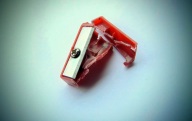.
Jamar loved his sister, his mom and his grandmom. Dad was “away.” Grandmom had court appointed custody because of the abuse Jamar had suffered from Mom’s boyfriend.
Grandmom was exhausted from her day job and her new, ‘parent’ status, so some weekends she still sent the kids back to Mom.
Several weekend “surprise” visits from Mom’s boyfriend included more extended, intense abuse where Jamar’s screams were muffled by stuffing socks in his mouth. It was more than 8 year-old Jamar could bear. He was taken to the Crisis Center after attempting suicide.
The chronic fear and stress has changed the physical architecture of Jamar’s brain.
Jamar is hypervigilant now, continually scanning everything and everyone for threats.
When a classmate innocently bumps him, Jamar flips instantly to hostile aggression mode. Jamar’s laser-like focus on social behaviors, his fears and misperceptions of threat keep him biologically hyperaroused, with a bias to action. Sometimes throwing chairs.
Jamar’s system is always a heartbeat away from high alert, or “hyperarousal” — a common neurobiological defense to developmental trauma. Engrained neurobiological stress responses and a chemical chain-reaction kick in automatically.
Developmental trauma defenses are varied and complex. Jamar’s hyperarousal contrasts sharply with another defense called ‘dissociation‘. There is much for us to learn.
Ultimately, when we peel back the layers on Jamar’s behavior, we learn to respond dramatically differently.
Whether abuse, family dysfunction or neglect, childhood trauma impacts 2 out of 3 kids. Experts call it “epidemic.”
Trauma-Informed adults CAN make a difference.
Get Informed. Click on the links below.
.
Informed already? Then, please “share” the blog post. Help grow awareness of this secret epidemic destroying childhoods.
.
.
Understanding the Behavioral and Emotional Consequences of Child Abuse CLICK HERE
.
National Child Traumatic Stress Network; Trauma Defenses __ CLICK HERE
.
.
After trauma, social interpretations change CLICK HERE
.
.
.
.
.
Look for other parts of this series “Nowhere to Hide” on LucidWitness.com for more information.
.
“Nowhere to Hide” series overview
click HERE

“Nowhere to Hide” series links
Each separate, individual article in the series focuses on a single component of the workings of developmental trauma, via real life examples in short “60 second” soundbites, akin to “Public Service Announcements” (PSAs). They are designed for sharing in social media networks to grow public awareness.
Trigger warning:
The children’s experiences in the vignettes are unvarnished. Their traumatic responses may trigger painful memories.
.
“PSA” Links for social media
.
Nowhere to Hide: Maria; Fight, flight or freeze

Nowhere to Hide: Andre’s Fear; What are Adverse Childhood Experiences?

Nowhere to Hide: Jamar’s Hyper-arousal

Nowhere to Hide: Roberto’s Dissociation

Nowhere to Hide: Danny’s Memory

Nowhere to Hide: Ashley’s “Normal” Education? Part 1

Nowhere to Hide: Ashley’s “Normal” Education? Part 2

More to come
.
“Like” us at “Trauma-Informed Pedagogy” on Facebook
.
Please share a PSA link to help grow public awareness of the impacts of developmental trauma. There are so many of us who’ve never heard of the overpowering life-long impacts.
.
“Peek Inside a Classroom” series overview
The second original series, “Peek Inside a Classroom”, provides much more detailed looks inside my classroom, primarily focused on specific students: Jasmine, Danny and José.
Other children are captured in broader looks at education reform concepts: “Failing Schools or Failing Paradigm?” and “Effective Education Reform”, co-authored with Sandra L. Bloom, M. D..
.
“Peek Inside a Classroom” series links
.
Peek Inside a Classroom: Jasmine

Peek Inside a Classroom: Danny


Peek Inside a Classroom: Failing Schools or Failing Paradigm?
Peek Inside a Classroom: Effective Education Reform (with Sandra Bloom, M.D.)
.
“Click for Resources…” series overview:
“Click for Resources” posts are the theory and research behind the narrative posts in “Nowhere to Hide” and “Peek Inside a Classroom”.
Each post in “Click for Resources “ is divided in three parts:
1) general press articles,
2) Research Journals or academic papers
3) social media, often with video.
.
“Click for Resources” series links:
.
1. Adverse Childhood Experience (ACE) Studies: CLICK HERE
2. Impacts of Childhood Trauma: Overview CLICK HERE
Click for Resources: Social Media on Impacts of Childhood Trauma
Click for Resources: Journal Articles on Impacts of Developmental Trauma
3. Trauma-Informed Schools CLICK HERE

4. Trauma-Informed Social Services CLICK HERE

5. Trauma-Informed Juvenile Justice CLICK HERE

6. Trauma-Informed Public Policy CLICK HERE

7. Childhood Trauma Training and Tools CLICK HERE

8. Book and Publication selections CLICK HERE

9. #800 phone numbers CLICK HERE

Developmental trauma, still “the elephant in the [class] room” for many adults.
.
“Like” us at “Trauma-Informed Pedagogy” on Facebook
.









21 thoughts on “* * NOWHERE TO HIDE * * Jamar’s Hyperarousal Defense”